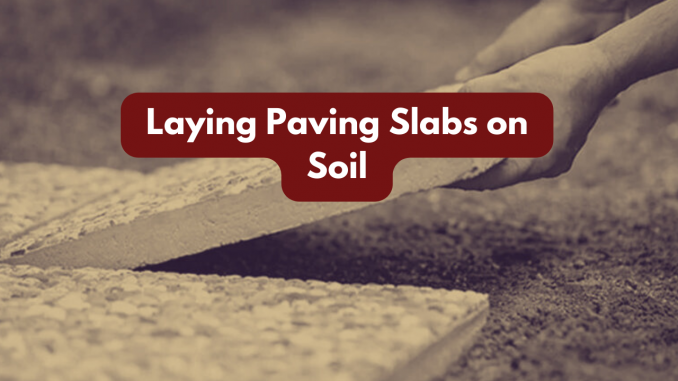
Laying paving slabs directly on soil isn’t the most recommended method, as it can lead to movement and settling over time, as this is quite similar to laying paving slabs on soil. However, if you’re on a tight budget or have a small area, and the soil is well-draining and stable, it can be done with careful preparation.
The Negatives of Laying Paving Slabs on Soil
Laying paving slabs directly on soil can have several consequences, both positive and negative. Here’s a breakdown:
Uneven settling: The biggest negative of laying paving slabs on soil is the uneven settling, as it can shift and compact over time, causing the slabs to sink or become uneven, creating tripping hazards and water pooling.
Limited durability: This method isn’t suitable for heavy use or harsh weather conditions. Slabs might crack, break, or move excessively.
Weed Growth: Weeds can push through gaps between slabs, requiring regular maintenance.
Restricted Slab Size: Larger slabs are more prone to movement on soil, limiting your design options.
Frost heave: In freezing climates, soil can expand with frost, potentially lifting and damaging the slabs.
Laying paving slabs directly on soil can be a budget-friendly option for small, low-traffic areas with well-draining soil. However, it comes with significant drawbacks regarding durability, stability, and maintenance. For long-lasting and reliable results, especially for larger areas or heavy use, consider a concrete base or consulting a professional for a more robust foundation.
Remember, the specific consequences will depend on your individual context, including soil type, climate, and intended use. Weigh the pros and cons carefully before making a decision.
The Benefits of Laying Paving Slabs on Soil
Laying paving slabs on soil offers a multitude of benefits, making it a popular choice for outdoor landscaping projects. Here are some of the key advantages:
Versatility: Paving slabs can be used to create a wide range of outdoor features, including patios, pathways, driveways, seating areas, and more. Their versatility allows homeowners to customise their outdoor space according to their preferences and needs.
Durability: When properly installed, paving slabs provide a durable and long-lasting surface that can withstand heavy foot traffic, weather exposure, and other outdoor elements. This durability makes them an excellent choice for high-traffic areas and outdoor entertaining spaces.
Aesthetic appeal: Paving slabs come in a variety of shapes, sizes, colours, and textures, allowing for endless design possibilities. Whether you prefer a sleek and modern look or a more rustic and natural aesthetic, there are paving slabs to suit every style and taste.
Easy maintenance: Unlike grass or gravel surfaces, paving slabs require minimal maintenance to keep them looking their best. Regular sweeping and occasional washing are typically all that’s needed to keep the surface clean and free of debris. Additionally, sealing the slabs can help protect them from stains and prolong their lifespan.
Weed control: By laying paving slabs on soil and using a weed membrane underneath, homeowners can effectively prevent weed growth between the slabs. This helps to maintain a tidy and weed-free outdoor space with minimal effort.
Increased property value: Well-designed outdoor spaces can significantly enhance the overall value and curb appeal of a property. Laying paving slabs on soil can improve the aesthetics and functionality of your outdoor area, making it more attractive to potential buyers and increasing your property’s resale value.
DIY-friendly installation: Laying paving slabs on soil is a relatively straightforward DIY project that many homeowners can tackle themselves with the right tools and materials. This can save money on installation costs and give homeowners a sense of pride and satisfaction in completing the project themselves.
Overall, laying paving slabs on soil offers numerous benefits, including versatility, durability, aesthetic appeal, easy maintenance, weed control, increased property value, and DIY-friendly installation. Whether you’re creating a patio, a pathway, or a driveway, paving slabs provide a practical and stylish solution for enhancing your outdoor space.
Guide to Laying Paving Slabs on Soil
Preparation:
- Mark and excavate: Mark the area with string and stakes, then dig out the soil to a depth of at least 150mm (adjust based on slab thickness). Ensure a slight fall for drainage (around 1:40).
- Sub-base: Add a layer of compacted sub-base material like MOT Type 1 (100mm thick). Compact well using a vibrating plate.
- Weed membrane: Optional, but recommended to suppress weeds.
- Bedding layer: Lay a 50mm layer of sharp sand on top, level, and compact again.
Laying the slabs:
- Mortar or sand: Decide your method. Mortar (3:1 sand:cement mix) offers more stability but requires more work. Sharp sand allows for drainage but may require edging to stay in place.
- Start from a corner: Lay the first slab level using a spirit level and tap it gently with a rubber mallet.
- Work in sections: Lay one or two slabs at a time, ensuring even gaps (use spacers) and level placement. Check levels often.
- Cutting: Use a slab splitter or grinder for cutting.
- Jointing: For mortar, fill gaps with mortar after laying a section. For sand, use kiln-dried sand after all slabs are laid.
Additional tips:
- Dampen the slabs before laying to prevent them from drying out the mortar.
- Consider edging the area with timber or edging restraints to keep the sand in place.
- This method is best for light foot traffic. For heavier use or unstable soil, consult a professional for a more robust base.
Remember, laying directly on soil may have drawbacks like uneven settling or weed growth. For a more durable and long-lasting result, consider a concrete base or seeking professional advice.

Leave a Reply